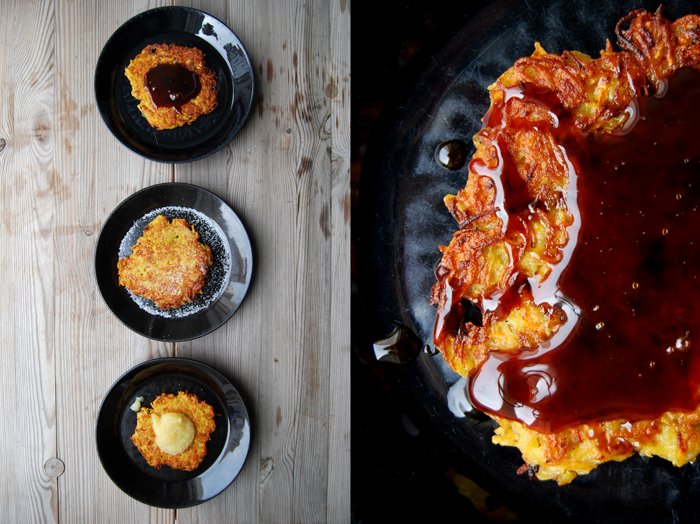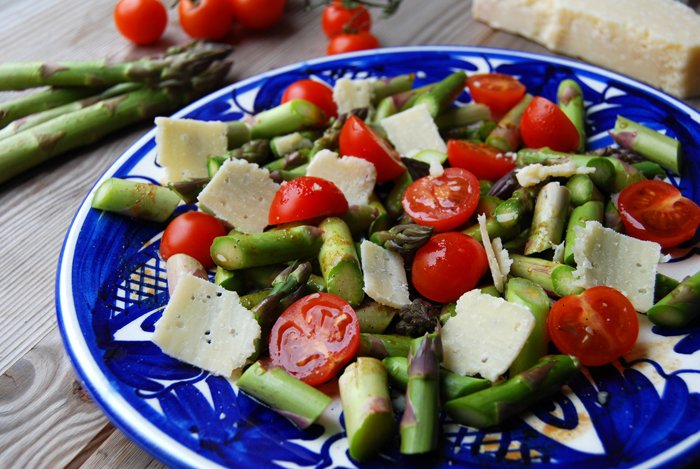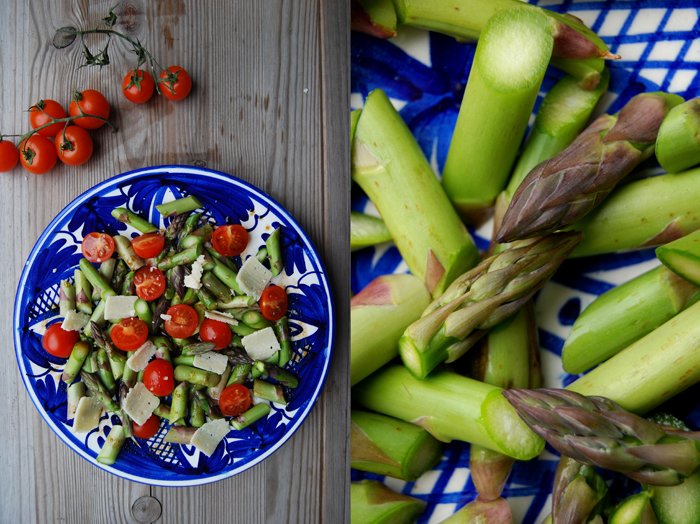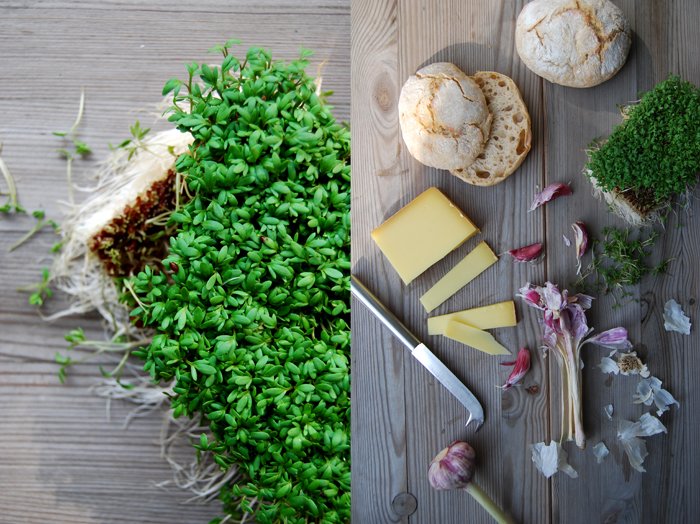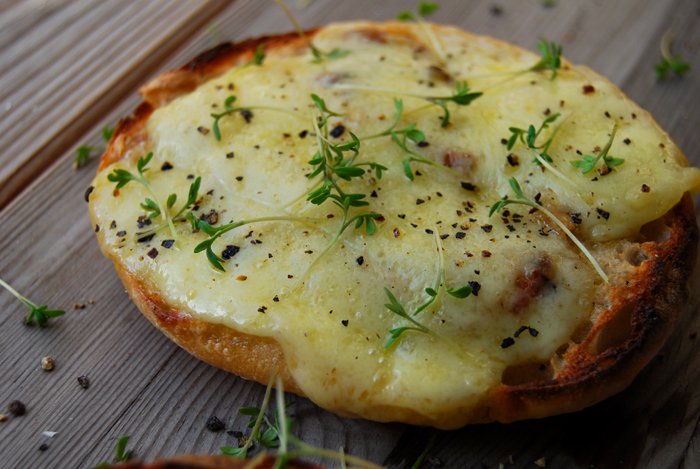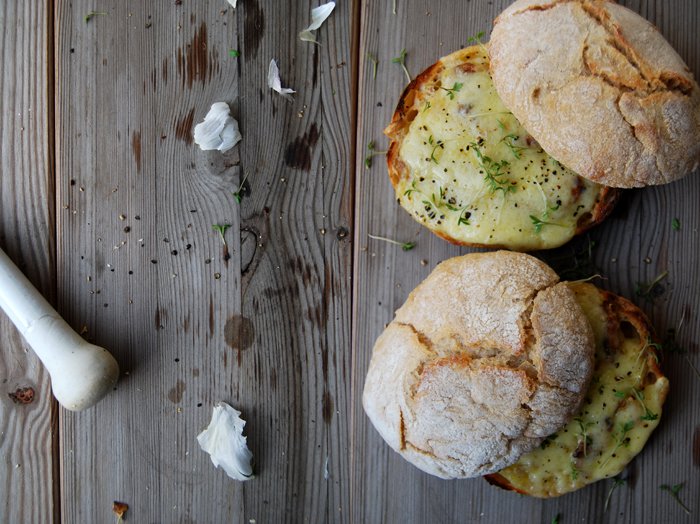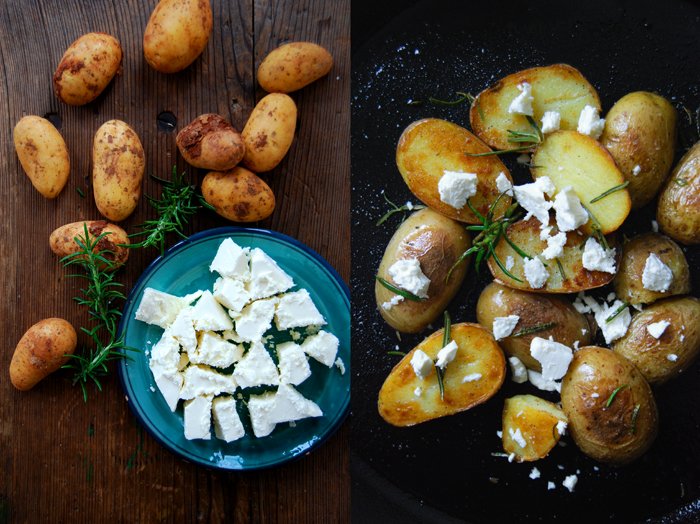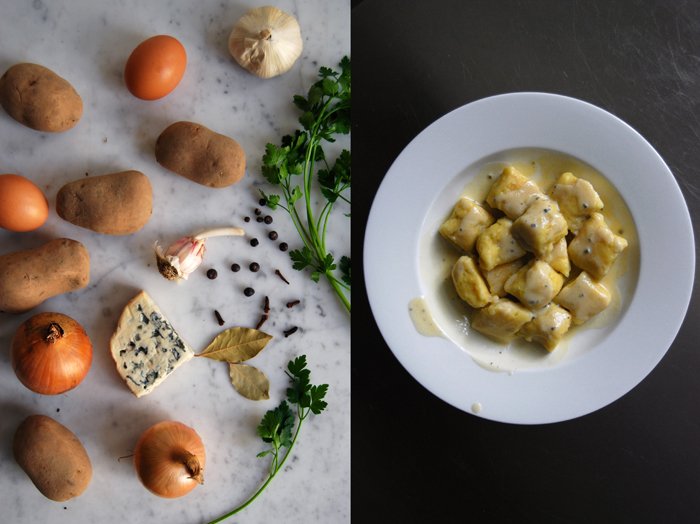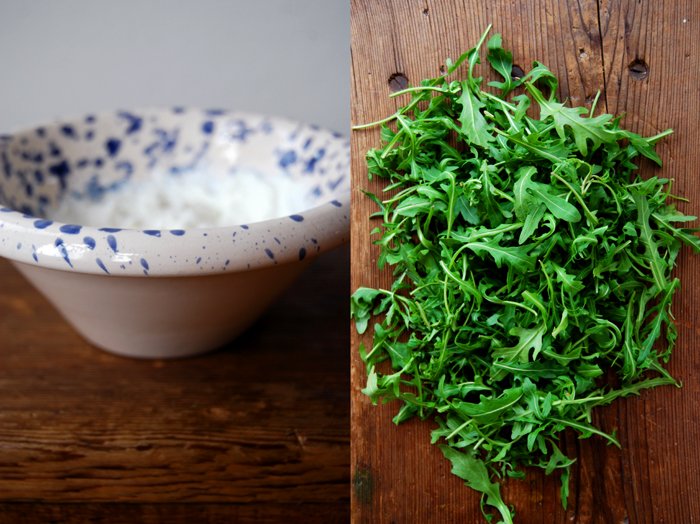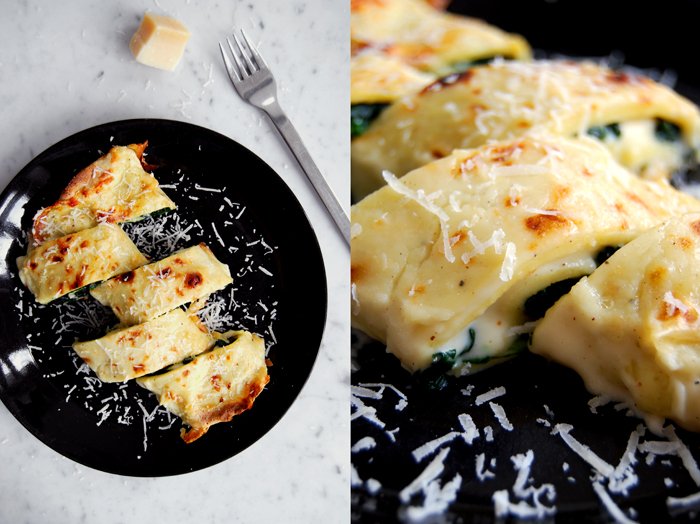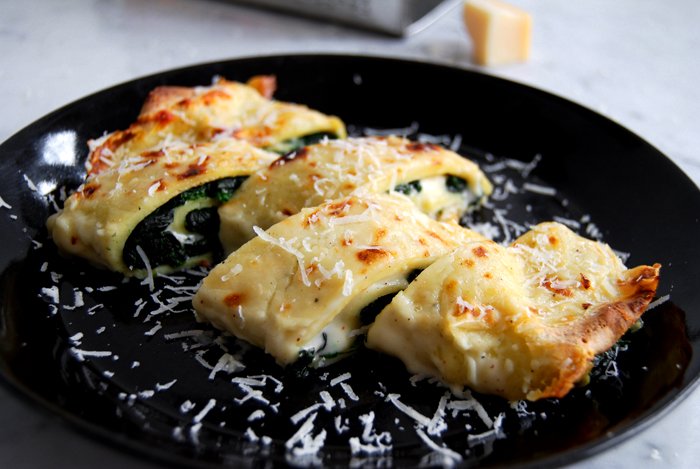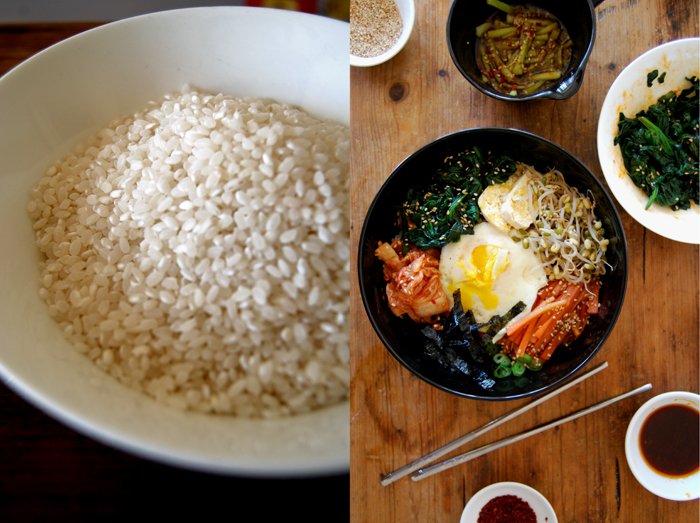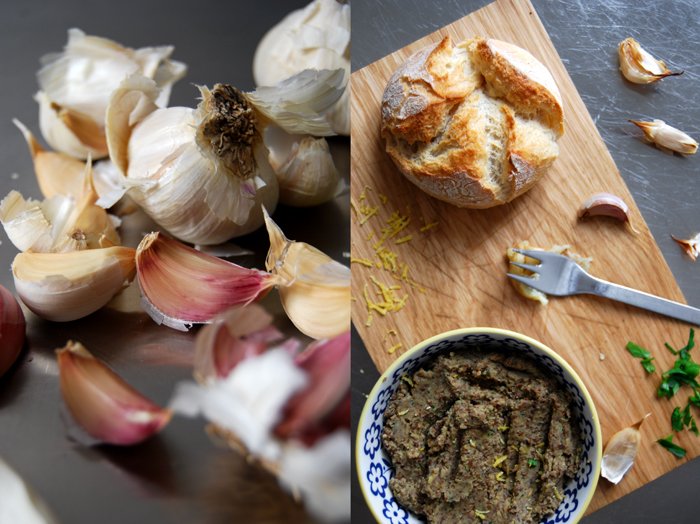Bean and Ramp Quiche
Quiche is one of those dishes which makes me feel good, always, no matter what my day has been like. As soon as I see a quiche in my oven and smell its buttery aroma spread through the kitchen I have to smile. Maybe it's the butter, or the eggs or the fact that I can look forward to another tart on my plate! That's why I've already written about a couple of my quiche recipes, my classic quiche with leek, tomatoes and thyme, an Italian-style tart with fennel and parmesan and here is another one, packed with greens. I fill this savory tart with beans, ramp (wild garlic) and spring onions and it has a deliciously light spring feeling!
I've praised its short crust at length which is so crisp and buttery, to me it's just perfect. My quiches always have a thin layer of an eggy and creamy mixture to keep it light and to leave space for the vegetable filling. Some recipes focus on the creamy filling which can make a quiche too rich and heavy, at least for my taste. I want to be able to eat a piece of quiche with my fingers, a tart for a picnic!
Bean and Ramp Quiche
For one quiche you need a round (27cm / 10.5″) or oval baking dish or tart pan.
For the short crust base
flour 250g / 8.5 ounces (I use spelt flour type 630 but you can use any other plain flour)
butter, cold 125g / 4.5 ounces
organic egg 1
salt 1 teaspoon
Combine the flour with the salt. Cut the butter with a knife into the flour until there are just little pieces of butter left. Continue with your fingers and work the butter into the flour until combined (there shouldn’t be any lumps of butter left). Add the egg and continue mixing with the hooks of your mixer until you have a crumbly mixture. Form a disc, wrap in cling film and put in the freezer for 10 minutes.
For the filling
green beans 200g / 7 ounces
ramp (wild garlic), just the leaves, cut into slices, 30g / 1 ounce
spring onion, cut into slices, 1/2
organic eggs 3
heavy cream 125 ml
crème fraiche or sour cream 125ml
salt 1 teaspoon
ground black pepper
nutmeg, freshly grated, a generous amount
The quiche
Set the oven to 210°C / 410°F top/ bottom heat.
Blanche the beans in plenty of salted water for a couple minutes until al dente.
Mix the eggs with the heavy cream, crème fraiche, salt, pepper and nutmeg.
Roll out the dough between cling film and line your baking dish with the flat pastry. Prick it with a fork and blind-bake in the hot oven for 10 minutes. Take your baking dish out of the oven and set the temperature down to 180°C / 355°F.
Spread the beans, ramp and spring onions on top of the pre-baked pastry base and pour the liquid mixture over it. Put the quiche on a baking sheet in the oven and bake for about 45 minutes or until golden, the top should be firm. Let it cool for 10 minutes.
My Grandmother's Kartoffelpuffer
My grandmother's kitchen had a wooden bench on one side, with a table and three chairs in front of a window from which I could see her peaceful garden. I used to sit there while she cooked for me, busy with her pots and pans preparing my favourite dishes. She grew beautiful roses next to a meadow which was covered in daisies blooming under the branches of her big cherry tree. It was the most perfect cherry tree, with a swing that made me feel like I could touch the sky! I could sit and swing for hours, daydreaming or waiting for my granny's lunch. Whenever I visited her for a couple days she asked me for a list of things I would like to eat. I used to give her a long list, always too long to be able to eat all of my favourites but I loved this ritual!
One of these lunches, my personal highlight that I always had to have at least once, was a fried cake made of grated potatoes, carrots, celery, onions, flour and eggs. It was crisp on the outside and juicy inside, similar to latke. Where I come from they are called Reibekuchen or Kartoffelpuffer meaning grated cake or potato cushions. We eat them with apple compote, sugar beet syrup or sugar which was my childhood favourite!
Kartoffelpuffer
For 3-4 people you need
potatoes, peeled and grated, 700g / 25 ounces
celeriac (celery root), peeled and grated, 150g / 5.5 ounces
carrots, peeled and grated, 200g / 7 ounces
large onions, peeled and grated, 2
plain flour 130g / 4.5 ounces
salt 2 heaping teaspoons
ground black pepper
vegetable oil for frying
granulated sugar for sprinkling
apple compote to serve
sugar beet syrup to serve
Squeeze the liquid out of the grated vegetables, dry them between kitchen role and mix with the other ingredients to a dough.
In a large heavy pan heat up the oil on highest temperature, the oil should cover the bottom about 1/2 cm / 1/4". When it's hot scoop about 3 tablespoons of the dough into the pan for each cake and even it out. I fry 3 cakes at a time. When they are golden brown, turn them around. They need around 2-3 minutes on each side, you might have to turn the temperature down a little. Take them out of the pan and put between kitchen role to soak the oil. Serve with sugar, apple compote or sugar beet syrup. If you prefer a savory version you can serve them with smoked salmon or my gravad lax.
Raw Asparagus Salad with Cherry Tomatoes and Parmesan
This is the best (and quickest) spring salad I've had so far this year, raw green asparagus with cherry tomatoes, thin slices of young parmesan and a light olive oil and Balsamico vinegar dressing. It combines the best of the season, crunchy, fresh and milky! It was the first time that I ever tried raw asparagus in my kitchen and I was impressed by how good it tastes. I didn't peel the stems, I just cut the bottoms off and before I started preparing the salad I cut a small piece of asparagus to find out how its texture would feel and taste in my mouth. I expected it to be a bit hard and woody but experienced quite the contrary. The outside felt a bit crunchy but the inside was almost tender. After it passed the test I could continue with the preparations for my first raw asparagus salad!
As a side dish or starter for 4, cut the woody bottom part (around 2 cm / 1") off of 500g / 1 pound of medium sized green asparagus and rinse the stems. Cut 16 cherry tomatoes in half and mix with the asparagus. For the dressing, whisk 3 tablespoons of olive oil with 1 tablespoon of dark Balsamico and 1 tablespoon of white Balsamico vinegar. Season with salt and pepper to taste and sprinkle over the salad. Slice 70g / 2.5 ounces of young Parmesan thinly and arrange on top of the salad.
Roast Garlic and Gruyère Sandwich
Garlic roasted in its skin is one of these things I can never have (or make) enough of. No matter how many of these little cloves I throw into the hot oven, I always feel like I could have made more. They cook in their delicate peel like in a little parchment pouch, steaming, softening and unfolding all of their wonderful flavours. It tastes less spicy than raw garlic but yet so aromatic, almost sweet and the texture is smooth, a bit oily. It's a great spread on bread!
Garlic is considered a natural antibiotic which has lots of positive effects on the body. It strengthens the immune system, stops free radicals and slows down the aging process. A tiny bulb that does a lot of good for our body! I strongly believe in the healing and strengthening powers of natural and good quality food. This is one of the reasons why I buy organic food as much as possible. I want natural food which is kept natural, no GMOs, no pesticides. Food in harmony with nature and not fighting against nature. A few years ago I started to drink organic green tea with freshly squeezed lemon juice every morning, since then I haven't had a single cold. It’s my natural booster for my immune system.
There must be something in garlic that my body loves and when it comes to roast garlic I feel like I could eat it with a spoon, in strong doses like in this sandwich made with 14 cloves of garlic for just 2 buns! I baked medium sized cloves of garlic in their skin in a 210°C / 410°F hot oven for about 12 minutes until golden and soft (you can cover them with aluminum foil if they start to get too dark). They were so soft that I could mash them with a fork, I just added some salt and spread the paste on the buns. I put a couple slices of Swiss Gruyère cheese on top (120g / 4.5 ounces for 4 halfs) and let them melt under the grill for 1-2 minutes until golden brown. I finished my sandwich off with crushed black pepper and some watercress sprinkled on top.
An oily and dense Ciabatta bread would have been good too but when I saw the Swiss Buns at the bakery which have a similar texture to the Italian bread I thought they would match the Gruyère cheese perfectly, it became a delicious and healthy Swiss sandwich!
Ricotta stuffed Zucchini in White Wine Sauce
When we have friends over for dinner, my mood always decides what treats I bring to the table. There are two options, I either feel like a sumptuous meal with several courses which might mean cooking for one or two days and which definitely requires good organisation before and on the night and most importantly enough time to enjoy all the preparations. The other approach is to take it easy and choose recipes which don't need a rigid plan. I just fill the table with plates full of food before or as our friends arrive and we all enjoy the night together. Eating, talking and laughing, drinking some wine of course, savoring and emptying the plates for hours. This was my choice when I had a dinner for 10 ahead of me a few days ago!
Some of our friends from Malta just moved to Berlin a few months ago. I know how much Maltese love and miss their home and food when they live abroad so I decided to make a traditional Maltese recipe, zucchini stuffed with lemon ricotta. I would have loved to get the small round courgette (Qarabaghliin Maltese) which would have been perfect for this recipe as you can close the stuffed fruit from the top. I worried that the ricotta would run down the sides of my long zucchini when I closed them but it worked fine. I cooked them for an hour in white wine together with the fried pulp of the fruits and some onions. Just a little of the creamy cheese went into the sauce and added some nice creaminess.
In the late afternoon, I cooked the zucchinis and left them al dente. I didn't want them to turn soggy as I had to warm them up again before our guests arrived. I filled my dining table with three different kinds of quiche which are very easy to prepare in advance and I can't really say if I prefer them warm or cold. Two loaves of homemade bread and a big batch of my raspberry chocolate brownies were on my list as well, both are great nibbles for a long night. When we all gathered around the table and I brought the dish with the steaming zucchini I didn't know that the night would go on for so long - our last guests left at 5 in the morning or so I was told, I fell asleep on the sofa at 4!
Zucchini stuffed with Lemon Basil Ricotta in White Wine Sauce
For 2 hungry people or for 4 when you have starters, you need
zucchini / courgette, cut in half (lengthwise) 2 (around 500g / 1 pound)
ricotta 200g / 7 ounces
Parmesan, grated, 20g / 1 ounce
organic eggs 2
basil, chopped roughly, 10 large leaves
lemon zest 1 teaspoon
salt 1/2 teaspoon
crushed black peppercorns
medium sized onion, chopped finely, 1
garlic, cut in half, 2 cloves
fresh parsley 3 sprigs
white wine 1 glass
tomato paste 1 tablespoon
olive oil for frying
Whisk the ricotta together with the parmesan, eggs, basil, lemon zest, salt and pepper.
Scrape the pulp out of the zucchini with a small spoon and set aside. Season the inside of the zucchini with a little salt and pepper and fill both sides with the ricotta mixture. Close them just before you put them into the casserole.
In a large pot or casserole with a lid (big enough for the zucchinis), fry the onions in a little oil till golden and soft on medium heat. Add the garlic and the pulp and fry for 2-3 minutes, deglaze with some white wine and add the sprigs of parsley. Put the stuffed zucchini on top of the onions, add some more wine (1-2cm / 1/2-1" of the bottom should be covered), close with a lid and cook for 1 hour on low - medium heat. Check after 2o minutes, you may have to add some more wine, the bottom should remain covered.
When the zucchinis are soft at the bottom and al dente at the top, take them out with 2 spatulas, carefully, and set them aside. Take out the parsley, add the tomato paste to the sauce and season with salt and pepper to taste. Serve the zucchini together with the sauce.
The Family Waffles and Prokofiev's Peter and the Wolf
I used to have cosy tea time ceremonies with my mother and my sister on the weekends, just the three of us. We lit candles, got comfy in between piles of cushions and listened to music. I always wanted to play either Prokofiev's Peter and the Wolf or Ravel's Bolero, both dramatic and mesmerising. It fascinated me as a child, especially Prokofiev's musical fairy tale, just a narrator telling the exciting story and an orchestra interpreting the characters and scenes. It made me feel like I was right in the story, I could see Peter following the cat through the grass and then, the scene when the duck escapes through the garden gate which little Peter had left open! He shouldn't have because of the wolf (his grandfather had told him a million times) and as one can imagine, it doesn't look so good for the duck. I don't want to reveal the end of the story, I still love listening to it!
When we had our girly afternoons, we either baked a cake or made waffles, my grandmother's waffles who passed her much-loved recipe on to my mother and her siblings before the grandchildren started baking them as well. I'm one of them, still enjoying them as much as my family does. I never made any other waffle recipe myself but I've obviously had others. I'm biased, I know, never as good as my granny's! Hers are light and fluffy, not too sweet as the dough is made with only a pinch of sugar. She used to sprinkle the sugar on top of the waffles after they were baked, still warm out of the waffle maker, which is how I make them too, sometimes with some cinnamon mixed in.
When I thought of my grandmother, I remembered her gold rimmed plates which I don't use very often. I ate my waffles like I always do, sandwiched with whipped cream in between and I played Peter and the Wolf, all the sweet memories came back and with them a happy and thankful feeling!
This recipe has been featured by Food52!
Waffles with Cinnamon Sugar and Whipped Cream
For the 8 waffles you need
butter 50g / 2 ounces
milk 175ml (if you use a Belgium style waffle maker you need only 150ml of milk)
organic eggs 3
a pinch of salt
granulated sugar 1 teaspoon
plain flour 100g / 3.5 ounces
baking powder 1/2 teaspoon
a pinch of fresh vanilla
For the topping
granulated sugar 70g / 2.5 ounces plus 1 tablespoon for the whipped cream
ground cinnamon 1/2 teaspoon
whipping cream 200ml
Warm up your waffle maker.
Combine the sugar and cinnamon to sprinkle on the waffles and whip the cream together with a tablespoon of sugar.
Melt the butter and mix with the milk. Combine the flour and baking powder. Beat the egg whites with a pinch of salt till stiff. Mix the egg yolks with the sugar and vanilla till fluffy and add the milk and flour, mix well. With a spoon, fold the stiff egg whites gently into the dough until well combined.
Pour a ladle of the dough onto the waffle maker and bake until golden brown. Sprinkle with the cinnamon sugar while the waffles are still warm and served with whipped cream.
Savory Zucchini Bread
I've wanted to learn how to bake sourdough bread for years, the only problem is that I bake and love so many of my yeast bread recipes that, so far I've never approached this adventure. Dry or fresh yeast allows me to make a fresh and warm bread within a couple hours where as sourdough demands days of preparation. Most of the time, my baking isn't really planned far ahead, my mood decides what I will put in the oven. With the right ingredients a yeast bread is wonderfully juicy and spongy but I have to admit that it never creates a crust comparable to the more time-consuming alternative which also has the advantage that you can keep it for days. This is impossible with yeast bread, but to be honest that has never been an issue as all the fresh bread coming out of my kitchen doesn't survive for more than a day or two!
I know that one day sooner or later I will give the sourdough a try, but till then there is still a lot of bread to bake. One option, which is as juicy as my olive bread, is a loaf made with grated zucchini (courgette) which makes the texture so soft and spongy that it doesn't need more than some olive oil or butter spread on top. I served it with ramp (yes, again) butter when we had some friends over and I liked that a lot as well, it made it a bit garlicky.
It's really quick to bake, it only needs 20 minutes in the oven!
Savory Zuchini Bread
For 2 loaves of bread you need
plain flour 500g / 1 pound
dry yeast 1 package (for 500g / 1 pound of flour)
salt 1 heaping teaspoon plus 1/2 teaspoon for the zucchini
zucchini, grated 200g / 7 ounces
water, lukewarm, 225ml
olive oil for brushing
Put the grated zucchini in a sieve over a bowl, add 1/2 teaspoon of salt and mix with your fingers. Set aside for 15 minutes, rinse under cold water for a few seconds and squeeze the water out with your hands. Spread the zucchini on a tea towel and push another towel on top to dry. Scrape off the towel and set aside.
Combine the dry ingredients, add the zucchini and water and mix with your dough hooks for 5 minutes until well combined. Continue kneading with your hands for a few minutes until you have an elastic dough ball. Put the dough back into the bowl and cover with a tea towel. Let the dough rise in a 35°C / 95°F warm oven for 45 minutes. This works really well but make sure that your oven is set to top/ bottom heat and not to fan.
Take the dough out, punch it down and knead for 1 minute. Form 2 long loaves and put on a baking sheet lined with parchment paper. Cover with a tea towel and let them rise for 30 minutes in the warm oven.
Set your oven to 220°C / 430°F.
Brush the loaves with a thin layer of olive oil and bake for 18 minutes or until cooked through. If you’re not sure if it’s done turn the bread around and knock on its underside, it should sound hollow. Let it cool for a couple minutes before you enjoy the first slice of your freshly baked bread.
Radicchio with Caramelised Red Onions and Lemon Thyme
In the past few days I've had caramelised onions on my mind, sweet and syrupy, preferably the red ones or shallots which taste softer and reveal an intense natural sweetness when they are cooked. There is a big bowl in my kitchen which is always filled with onions. I like to have the whole range at hand, red, yellow, white, big and small, but most of the time I use the spicy yellow bulbs, mine are medium sized and organic, they bring tears to my eyes as soon as the knife touches the peel. They are great too cook with but painful to prepare! A few shallots are in the bowl as well and red onions of course which I love to use for pies or in salads, which rarely happens as I'm not too fond of raw onions.
I have a beautiful head of radicchio in my fridge just waiting to be used, the big leaves falling over its sides like a ball gown, almost too perfect to destroy! But I must, I want to combine its bitterness with the sweetness of caramelised red onions and some lemon thyme. The radicchio is uncooked but the onions caramelise in sugary butter, softening over less than 15 minutes before I deglaze their juices with dark Balsamico vinegar. The result is delicious, a salad of bitter sweet flavours glazed in a thick sweet and sour dressing!
A Salad of Radicchio, Caramelised Red Onions and Lemon Thyme
For a side dish for 2 you need
radicchio, torn into bite sized pieces, 4 big leaves
medium sized red onions, each cut into 8 pieces (lengthwise), 2
butter 3 tablespoons
sugar 2 tablespoons
balsamic vinegar 2 tablespoons
olive oil 4 tablespoons
lemon thyme, 10 young and soft sprigs chopped roughly or just the leaves
salt and black pepper
In a large pan, heat up 1 tablespoon of oil together with the butter and sugar on medium temperature. As soon as the butter starts to sizzle add the onions, stir once in a while. Let the onions soften over 10 minutes, they can become a bit dark but shouldn't burn as that would make them bitter. When the onions are soft, caramelised and have turned a dark red, season with salt and pepper and take them out keeping their caramel juices in the pan. Deglaze the bits and pieces left in the pan with the Balsamico, put on medium heat for a few seconds and mix it so that just a little of the vinegar evaporates. Take it off the heat, pour the liquid into a bowl, whisk with 3 tablespoons of olive oil and season with salt and pepper to taste.
On large plates, arrange the radicchio with the caramelised onions on top, carefully as they are very soft, sprinkle with some salt and pepper and add the thyme. Drizzle the thick dressing over the leaves, it's so strong that a few drops are enough to spread the sweet flavours.
Spicy Ramp Pesto with Spaghetti
When I wrote about my wild garlic soup two weeks ago, a couple of the more attentive followers of eat in my kitchen told me that "ramp" is the more common name for my beloved "wild garlic". I'm happy they let me know and to avoid confusion I will change its name in my recipes to "ramp". "Wild garlic" has a bit of an adventurous touch, I like that, it fits to its distinct taste but if only a few know it as such then I have to compromise.
At the moment, this plant is at its seasonal peak. The long leaves cover the moist ground in the forests, filling the air with their beautiful smell of fresh green onions. When I go to the market, I buy ramp in bulk as I'm a bit obsessed with it. I even start my shopping earlier in the morning just to make sure that I get enough of the little bunches for all the recipes I have in mind. The recipe I make the most (at least once a week) is a pesto, spicy and very strong in taste, great with pasta or spread on toasted dark bread which is an absolutely delicious snack! In the fridge, it stays fresh for a few days so I always prepare a big bowl.
For my pesto, I use the leaves of 2 bunches of ramp (around 90g / 3 ounces), rinsed and dried well, and mix them in a blender with 110ml of olive oil, 50g / 2 ounces of parmesan and 1/2 teaspoon of salt. You could add some pine nuts but I find them too weak to come through, I prefer to concentrate on the ramp and the cheese. When we eat the pesto with spaghetti or linguine I add some crushed pepper and more grated parmesan on the warm pasta.
Tomorrow I will write about a burger which didn't manage to escape my ramp obsession!
Crisp Golden Rosemary Potatoes with Feta Cheese
Some days call for a quick lunch or dinner and potatoes are often my solution - apart from pasta, of course. Mashed, fried, baked or in salads, preparations never take too long to create a satisfying meal which won't leave me hungry. Sometimes when I know that stressful days are ahead, I put a big pot of potatoes on the cooker, enough to be turned into a few delicious meals in the following days. This is perfect when there are fried potatoes on my cooking plan as they should always cool and dry after cooking before you throw them into the hot pan, that way they turn nice and crisp and won't become mushy. My favourites are the classic version with bacon and onions or a bit lighter and Mediterranean, golden fried potatoes with rosemary. I could leave it at that, good potatoes fried in olive oil with some herbs, sea salt and pepper don't really ask for more but I'm in the mood for cheese at the moment. I could throw it into anything, like last week's rocket salad with goat cheese, my Bavarian Obatzda sandwich with camembert or the gnocchi with blue cheese sauce.
So my potatoes get a cheesy add-on as well, in the form of Greek Feta cheese. I cut 500g / 1 pound of small cooked and cold potatoes in half and fry them in olive oil on medium heat until golden on all sides. For the last 2-3 minutes I add the needles of 3 small sprigs of rosemary, they become bitter when fried too long. When the potatoes are nice and crisp I season them with crushed black pepper and coarse sea salt and crumble 150g / 5.5 ounces of Feta cheese on top. A ripe goat cheese would work as well, or an aromatic French cheese like Comté grated and melted on the hot potatoes, so many options!
Gnocchi with Blue Cheese Sauce
As soon as the temperatures start to rise the Mediterranean influence on my cooking begins to increase accordingly. I feel like olives, fresh herbs, capers and garlic, lemons and seafood, and all the fresh vegetables which finally start to grow. The tomatoes and cucumbers start to taste strong again and yesterday I bought my first bottle of rosé wine of the year, another sign of the official start of the new season!
From now on, I could just live of pasta, vegetables, simple dishes which sparkle through the ripe flavours of their ingredients, basically Italian cooking which refines minimal dishes to perfection and celebrates each single element of a dish. A great example are gnocchi. After I ate my own, homemade gnocchi for the first time I couldn't enjoy the store bought ones anymore. The dough is so easy to make, potato and nutmeg as the dominant flavours, flour, eggs, butter, salt and pepper mixed together and shaped into little gnocchi. Far less complicated than homemade pasta as long as one rule is obeyed, the potatoes must have cooled off before mixed with the flour. Apart from that it's an unbelievably easy dinner and so delicious that some sage leaves fried in olive oil and some grated parmesan would be enough to make me happy. If only there wasn't this amazing blue cheese sauce that I fell in love with a couple years ago. It's smooth but aromatic, cooked with garlic, onions, parsley, juniper berries, cloves and bay leaf which are taken out before the blue cheese is mixed in. I use Fourme d'Ambert cheese from the Auvergne region in France which is creamy but very strong in taste, the gnocchi just need to be glazed with the sauce, enough to enjoy all the intense aromas.
In January I made my wintery gnocchi with pumpkin and potatoes and a walnut pesto. Sometimes I mix spinach into my gnocchi dough which I have to make again, soon, as there is nice and crunchy spinach at the moment!
Gnocchi with a Fourme d'Ambert Blue Cheese Sauce
It's best to use floury potatoes with a fluffy and dry texture for the gnocchi dough. Keep in mind that you don't mix the flour with the cooked potatoes unless they are absolutely cold.
For 2-3 people you need
For the Blue Cheese Sauce
small onion, chopped, 1
garlic, cut in half, 1
butter 30g / 1 ounce
milk 125ml
heavy cream 125ml
white wine 150ml
fresh parsley 3 sprigs
cloves 2
juniper berries 2
bay leaf 1
black peppercorns 4
blue cheese such as Fourme d'Ambert 45g / 2 ounces
In a sauce pan, fry the onions and garlic in butter until golden and soft, add the other ingredients except the blue cheese and bring to the boil. Let it simmer for 10 minutes on medium heat, pour through a sieve and add the cheese. When the cheese has melted, let the sauce simmer for 5-8 minutes on low heat until it starts to thicken slightly. Season with salt and pepper.
For the Gnocchi
potatoes, cut into cubes, 450g / 16 ounces
butter 30g / 1 ounce
organic egg yolks 2
plain flour 125g / 4.5 ounces
nutmeg, grated
salt 1 1/2 teaspoons
black pepper
Cook the the potatoes in salted water until soft (around 15 minutes). Drain them when they are done. Press the drained potatoes through a potato ricer and mix immediately with the butter and egg yolks. Put in a cool place (in the fridge) until the mixture is completely cool.
In a large pot, bring plenty of salted water to the boil. Set the oven to 100°C / 210°F and put an ovenproof dish inside. You will need it to keep the gnocchi warm while you cook them in batches.
With a spoon (or your hands), mix the cold potato mixture with the flour, salt, nutmeg and pepper until combined. Dust your hands with flour and roll the dough – in batches – into sausage shapes on a well floured working surface and cut off 3x3cm / 1x1″gnocchi. If you like you can roll them on a fork for the typical gnocchi pattern. Put them onto a floured baking sheet.
Cook your gnocchi in batches in the boiling water so that they can float. After 3 minutes, when they start to come up and float on the surface take them out with a slotted ladle and drain them. Keep them in the warm dish in the oven until you are done with the last batch.
Arrange the gnocchi on plates and pour some of the blue cheese sauce over them.
A Bavarian Sandwich with Obatzda and spicy Radish
In a Bavarian beer garden, you can be sure you will find plenty of beer, sausages and at vesper time a traditional delicacy which is served with bread, I'm talking about Obatzda also known as Obatzter meaning mashed. Drinking beer in Bavaria demands strong physical condition as it's served in a 1 liter mug, the "mass". You may imagine that it's quite helpful to have some rich food on the side when drinking such quantities (obviously people don't stop after their first "mass" of beer). Obatzda is one of them and it's offered in huge varieties. It's basically a cream made of aged cheese leftovers often mixed with either herbs or spices like hot paprika powder or caraway seeds, onion, garlic, a shot of beer, horseradish, butter, cream cheese, I could continue endlessly. It is, again one of those dishes that evolved in each region with each personal preference and local tradition.
My Obatzda is green, it's based on rucola and a middle-aged camembert and cream cheese. I added some radish and watercress to bring out the rucola's mild spiciness next to the rich and tangy cheese. White bread wouldn't have managed to keep up with these strong flavours, I used dark spelt bread. This sandwich needs a dense and juicy texture, strong bread with a nice crust. What is great about this dip is that you can really play around with the leftovers of your fridge. Spring onions, dried tomatoes, olives, all the ingredients mentioned above, you can create your own Obatzda after your own preferences. After your selection is made, mix everything in a blender or mash with a fork and spread on a slice of bread, a thick layer, this is a luscious Bavarian sandwich after all!
For a little bowl of Obatzda, I mixed 30g / 1 ounce of rucola with 50g / 2 ounces of aged camembert, 150g / 5.5 ounces of cream cheese and 1 tablespoon of heavy cream, seasoned with salt and pepper to taste. Depending on the camembert's age and tanginess you might need more or less cream cheese, the same with salt. When the dip is spread on a slice of bread, sprinkle with thin slices of radish and some watercress.
Rucola Salad with Goat Cheese, Honey Dressing and Pink Peppercorns
Here's the salad which accompanied yesterday's salmon with spice crust, rucola with goat cream cheese, crushed pink peppercorns and a sweet honey Balsamico vinegar dressing! I wanted to use both the pink and the green peppercorns which I had just bought at the market, not in the same dish but in the same meal. The spiciness of the green pepper fit perfectly with the crust I chose for the fish but my salad, sweet and milky, needed a mild and less spicy aroma, pink peppercorns. The berries matched the sourness of the creamy cheese very well which was so young that there was only a hint of goat milk. I could have used mozzarella instead but I wanted this special, slightly sharp aroma which balanced out the sweetness of my vinaigrette on the other side.
Usually, I make a quick dressing for my salads, 3 tablespoons of olive and 2 tablespoons of balsamic vinegar plus salt and pepper, but this salad asked for more. I kept the ratio of vinegar and oil but I mixed my dark balsamic vinegar with the white one and added 1 small teaspoon of honey (depending on the sweetness you want to achieve you might need more or less honey). It turned out thick, sticky and syrupy, exactly what I wanted! For 2 I spread 2 handfuls of rucola leaves on plates and sprinkled 125g / 4.5 ounces of fresh goat cream cheese in big lumps on top. I drizzled the dressing over the leaves and garnished my salad with 1 tablespoon of crushed pink peppercorns. It would have made us just as happy as a light and easy lunch on its own. I have to remember that, it will be perfect on a hot summer evening!
Wild Garlic Soup to start off the Spring
Walking through the forest is one thing I miss the most living in the city. Its earthy smell, the musty air captured by the trees changing with the seasons makes me feel at home. Especially in spring, when the green comes out again and everything smells light and fresh with the first flowers starting to blossom. I want to walk on soft soil watching nature unraveling around me!
One of the most distinct smells you can find at the moment when walking though a European forest close to a river or lake is the smell of garlic, wild garlic. Coming from a little plant which covers the ground in large areas and looks similar to lilies of the valley. It's a wild relative of chives also known as ramps, ramsons, buckrams, wood garlic or bear's garlic as they must be quite taken by it. In taste it's similar to chives but with a unique touch to it, spicy, a bit like garlic but fresher, more "green". The leaves are best when young and fresh, great in pesto, soups or to spice up other vegetables and meat.
I'm totally with the bears, I love cooking with it and when I spotted it at the market I got excited and had lots of recipes on my mind. Inspiration for the weeks to come! I will start with a tangy but smooth soup, the leaves of two bunches of wild garlic, potatoes, onion and a few spring onions on top. It doesn't take much to make this springy soup of the forest!
Wild Garlic Soup
For 4 people you need
wild garlic (ramps), rinsed and stems cut off, the leaves of 2 bunches (around 100g / 3.5 ounces)
potatoes, cut into cubes, 750g / 1.5 pounds
onions, chopped 2water 1500ml
heavy cream 180ml
salt and pepper
olive oil for frying
spring onion, cut into thin slices, 1, for the topping
In a large pot, bring the water to the boil and cook the wild garlic for 2 minutes. Take it out with a slotted ladle, rinse under cold water for a few seconds but keep the boiled water! Fry the onions in some oil until golden, add the potatoes, some salt and the water used to cook the wild garlic and cook for 12 minutes or until the potatoes are soft. Add the wild garlic and cream and mix in a blender till smooth. Season with salt and pepper and sprinkle with spring onions when served on plates.
Chicory Boats with Pear Dressing and Pink Peppercorns
Last week I bought some pink peppercorns, the first ones in years. I forgot about them after I used them the last time, I just emptied the jar and it never got refilled. Although the pink berry is the fruit of the Peruvian Pepper Tree it's not related to common pepper, it's just a berry. Nevertheless, I used to love them, on steak, in creamy sauces, and even on desserts. That's actually the reason why I bought them again, in the next few months I want to try out a few sweet combinations. They taste mild, with a flowery aroma, and offer lots of culinary possibilities but first I have to think about a few ideas. For now I'll start with a simple savory dish.
I have some finger food in mind, an easy in between nibble. I take the big leaves of 3 chicory (also known as Belgian endive) and dollop a little of a fruity dressing on top. It's made of 4 heaped tablespoons of yoghurt mixed with 3 teaspoons of tomato paste and 1 crunchy pear, grated without peel and stirred in as well. I season it with salt and black pepper and my pink peppercorns, crushed and sprinkled on top. The pink berries had a tasty return to my kitchen!
A Ginger Carrot Salad with Spring Onions
Carrots are unbelievably versatile and uncomplicated vegetables which create wonderfully easy but delicious side dishes, salads and soups. They never cause a hassle, always sweet and strong, they aren't very sensitive to prepare. When cooking fish or meat that demands all your attention, the carrots are patiently waiting on the side in their pot not loosing any of their qualities when left cooking a bit longer. The same goes for salads, you can mix them with the strongest flavours, go overboard with lemon, spices or herbs, no problem, this little orange root will manage!
I'll go easy on them in my salad, I just add some freshly grated ginger (1 1/2 tablespoons) to my dressing, made of 2 tablespoons of olive oil and 1 1/2 tablespoons of fresh lemon juice, some salt, pepper and 1/2 a teaspoon of sugar. 4 carrots peeled and cut into julienne are enough for a side dish for 2. Half a spring onion cut into thin slices sprinkled on top adds a bit of spiciness. The carrots still have enough space to show their sweet side.
Baked Crespelle with Spinach, Béchamel and Parmesan
Spinach combined with a creamy sauce, be it Béchamel, ricotta or a blue cheese sauce is a delicious filling for any kind of pasta. This combination doesn't need a lot of additional spices besides salt, pepper and nutmeg. It's one of those things that's best kept simple. I love it in cannelloni or lasagna but I'm extremely fond of it in crespelle, thin Italian pancakes, wrapped around a tasty filling. You could also use a sauce Bolognese but that wouldn't give the crespelle much space. Keep it pure and you can enjoy the eggy wrap complemented with a mild filling.
When I'm in Italy I have this meal with tomato sauce poured on top, it looks like the Italian flag, green, white and red. The man of the house asked for the green and white version, just some parmesan grated on top of the rolled crespelle before they bake in the oven for 15 minutes. They turn golden, partially crisp but the spinach and Béchamel mixture keeps it moist and juicy inside. You could also replace the spinach with chard, I do that sometimes, it's similar to my Chard and Ricotta Lasagna.
Baked Crespelle with Spinach, Béchamel and Parmesan
For 4 filled crespelle you need
spinach, rinsed, without stems, 350g / 12.5 ounces
fresh Parmesan, grated, 80g / 3 ounces
Cook the spinach in salted water for 1-2 minutes (the thick leaved spinach needs 2 minutes), rinse with cold water for a couple seconds and drain. Chopped roughly, season it with salt, pepper and nutmeg and set aside.
For the Sauce Béchamel
milk 600ml
butter, melted, 30g / 1 ounce
plain flour 30g / 1 ounce
bay leaf 1
a pinch of nutmeg, grated
salt and pepper
Mix the milk with the nutmeg, salt and pepper. Whisk the flour into the hot butter. Bring the milk to the boil and whisk into the roux. Continue mixing until smooth. Add the bay leaf and cook for around 5 minutes on low heat until the texture is thick and smooth. Take the bay leaf out and season with salt and pepper.
For the crespelle
milk 160ml
organic eggs 2
plain flour 130g / 4.5 ounces
salt 1/4 teaspoon
butter for frying
Mix the ingredients well and let the dough rest for 5 minutes. Heat some butter in a large pan and fry 4 thin crespelle one at a time, golden on both sides.
The filled crespelle
Set the oven to 200°C.
Lay a crespelle flat on a plate, spread with 1/4 of the spinach and 3 tablespoons of the Béchamel on top, roll into a wrap. Continue with the rest and put them next to each other in a baking dish. Pour the rest of the sauce on top and sprinkle with parmesan (keep some cheese for the baked crespelle, I like to put some fresh cheese on when they come out of the oven). Bake for 12 minutes or until golden brown. You can also switch on the grill for 1-2 minutes, that makes it partially crisp.
Yu-Kyong's Bibimbap, a traditional Korean treat
A few weeks ago I met a very sweet couple from Norway, Lena and Knut, we sat opposite each other at a supper club and started talking. Days later I found out about their wonderful blog Teak Tray Weekdays where they share little treasures of their daily life in Trondheim and their traveling trips, I got peacefully lost in their stories. When Lena asked me if I would like to cook something together with them I was very happy. I liked the idea of the three of us cooking the same meal in different kitchens in different countries and with different recipes. I let them choose what we would cook and they suggested Bibimbap. They had just been to Berlin and enjoyed this Korean speciality at a restaurant so much that they wanted to cook it at home.
At first, I wasn't sure about my approach to this meal. I had never cooked Korean before and I usually need an experience, a memory, a story, taste, something that opens the door to a new culinary experience. I asked my oldest friend Yu-Kyong for help, we lived next to each other through our whole childhood, she has Korean roots, her father grew up in North Korea and her mother in the South. She lived in Germany all her life but her mother cooks Korean for the family and introduced her daughter to the traditional recipes, like Bibimbap.
When I asked Yu-Kyong to write down the recipe so that I could buy all the ingredients she told me that this wouldn't work, we would have to go shopping together. We met at an Asian market and she gave me an introduction to Korean cooking. She explained the necessary spices, mixtures, spice pastes and preparations to me, all in between hundreds of boxes, tins and bottles of food, freezers stuffed with tiny crabs, octopus and fish. The scent of a different world in my nose, visually overwhelmed, I tried to keep up with her. She told me about the different flavours and qualities of sesame oil, I learnt how to cook sticky rice properly, which cutlery I have to use (a metal spoon and metal chopsticks, not wooden!) and so much more. Basically, a one hour crash course on Korean cooking, in the middle of an Asian market, typing everything more or less precisely into my phone, not to forget a single detail.
I got home with bags of vegetables, Kimchi, roasted seaweed, Obok Gochujang hot pepper paste, many colourful tins and boxes. I bought the first tofu of my life and I felt happy and finally prepared for this new cooking experience.
Here's a quick description of Bibimbap, it's a one pot meal, rice at the bottom and steamed vegetables mixed with a sesame oil and soy sauce dressing on top. I steamed spinach, sprouts and carrots and added strips of seaweed, Kimchi (spicy fermented cabbage), fried tofu and eggs. The spinach is glazed with the special Bibimbap Gochujang sauce which is mixed into the rice as well. I made a traditional cucumber salad on the side, mixed with sesame oil and soy sauce, sprinkled with chili powder and toasted sesame seeds.
This meal needs good preparation before you mix everything together, it's a ceremony of pure tastes mixed with the strong flavour of good quality sesame oil and the spiciness of Gochujang. When you make your own Bibimbap you should allow some extra time to enjoy the cutting, steaming and mixing, it's meditative. I learnt that this is not a warm meal, the rice and egg (which I fried in the end) have to be warm but the steamed vegetables can be cold.
Vegetable Bibimbap and Cucumber Salad
For 3-4 people you need
sticky rice, rinsed, 170g / 6 ounces
soybean sprouts, steamed for 1-2 minutes, a handful
spinach, steamed for 1-2 minutes, 250g / 9 ounces
carrot, cut into julienne, steamed for 1 minute, 1-2
tofu, cut into 0.5cm / 1/4" slices, 200g / 7 ounces
Kimchi 6 tablespoons
spring onions, cut into thin slices, a small handful
Korean roasted seaweed, cut into strips, 5 sheets
organic eggs 3-4
sesame seeds, toasted in a pan for a couple minutes on medium heat, 2 tablespoons
cucumber, peeled, cut in half, without the seeds and soft parts, a 15cm / 6" piece for the cucumber salad
dried chili spice for the cucumber salad, 1/8 teaspoon
Gochujang hot pepper paste 1 tablespoon
sesame oil 6 tablespoons
soy sauce 5 tablespoons
sugar
garlic, crushed, 4 cloves
Whisk the following ingredients for the sauce used for the steamed soybean sprouts, carrots and cucumber salad
4 1/2 tablespoons of the sesame oil
3 tablespoons of the soy sauce
1 1/2 tablespoons of sugar
3 small crushed cloves of garlic
Whisk the following ingredients for the Bibimbap sauce (used for the steamed spinach and the rice)
1 tablespoon of the Obok Gochujang hot pepper paste
1 1/2 tablespoons of the sesame oil
2 tablespoons of the soy sauce
3/4 tablespoon of sugar
1 small crushed clove of garlic
Cook the rice in a pot filled with water and a pinch of salt (the water should be 2cm / 1" above the rice) for 12 minutes, on medium heat, keeping the lid closed. If the rice is still hard and didn't soak all the water, keep it on the heat for a couple more minutes. When it's done, keep the rice covered and set aside.
For the salad, cut the cucumber into strips, mix with 1/3 of the dressing (not the Bibimbap sauce) and sprinkle with some sesame seeds and the dried chili spice. The cucumber salad is served as a side dish, not on top of the Bibimbap like the rest of the vegetables.
Glaze the steamed soybean sprouts with 1/3 of the dressing (not the Bibimbap sauce) and the steamed carrots with the rest of the sauce, sprinkle both with sesame seeds.
Mix the steamed spinach with 4 teaspoons of the special Bibimbap sauce (keep the rest of the sauce to mix with the rice).
Fry the tofu in a little sesame oil for 2 minutes until golden, turn gently and fry on the other side. When it's done, set it aside.
Fry the eggs, leaving the egg yolk soft.
Put the rice in a large bowl and the spinach, carrots, sprouts, Kimchi, spring onions, tofu and seaweed on top, arrange them in a circle next to each other. Place the fried eggs in the middle and sprinkle everything with sesame seeds.
When you serve the Bibimbap at the table, you can either mix everything in the bowl together with the rest of the Bibimbap sauce or divide it between the plates and add some sauce to it (that's how I did it).
Broccoli Pesto with Spaghetti and Sun-dried Tomatoes
Finally pesto! I love it, bunches of basil, parsley, chopped green or black olives, sun-dried tomatoes, capers, garlic, anchovies mixed with olive oil, nuts or cheese. There are endless possibilities to bring one of the most satisfying meals onto the table, pasta with pesto. It's so simple yet so special! When I make pesto I just follow my mood and appetite, picking what the kitchen herbs on my window sill offer and mixing it together with the Mediterranean fruits and vegetables preserved in salt or oil I keep in jars in my fridge. Sometimes I mix fresh vegetables in as well, like green asparagus or broccoli.
Today is a broccoli day! I cook it al dente, put some of it in a blender and mix it with parsley, ginger, garlic, anchovy, lemon juice and olive oil. Some of the water used to cook the broccoli stirred in makes the pesto nice and smooth, it's lighter than using just olive oil. When the warm spaghetti has been mixed with the broccoli pesto, I sprinkle some broccoli, sun-dried tomatoes and red chili on top. There are lots of different flavours in this pesto but they blend in perfectly and allow the broccoli to show its fresh side.
Broccoli Pesto with Spaghetti and Sun-dried Tomatoes
For this meal it's best to warm the plates in a 75°C / 165°F warm oven for a few minutes. I prepare them while the pasta is cooking.
For 4 people you need
spaghetti 400g / 14 ounces
broccoli, florets and the soft part of the stem, 450g / 16 ounces
water used to cook the broccoli 50ml
sun-dried tomatoes, cooked in a little water for 2 minutes to wash off the salt, dried and chopped, 1 1/2, for the topping
water used to cook the sun-dried tomatoes, 3 tablespoons
fresh parsley, chopped, 3 heaping tablespoons
garlic, crushed, 1 big clove
ginger, grated, 1/2 teaspoon
anchovy preserved in salt (optionally), rinsed and dried, 1
lemon juice 2 teaspoons
olive oil 3 tablespoons
salt and pepper
fresh red chili, chopped, 1, for the topping
In a large pot, bring water to the boil, add some salt and cook the broccoli al dente. Keep 1/3 of the cooked florets, cut into bite sized pieces and set aside.
Cook the spaghetti al dente.
Put the rest of the broccoli (florets and stem cut into pieces) in a blender and mix together with some of the water used to cook the broccoli and sun-dried tomatoes. Add the parsley, garlic, ginger, anchovy, lemon juice, olive oil and mix well. Season the pesto with salt and pepper but keep in mind that the tomatoes used for the topping will add some saltiness as well.
Arrange the spaghetti and the pesto on big plates and sprinkle with the chopped tomatoes, pieces of broccoli, chili and some more black pepper.
A Sandwich with Lemon Lentil Mousse and Roast Garlic
The legume section in my pantry is overflowing, it's time to empty some lentil boxes! My plan is to make a smooth lentil mousse enhanced with parsley, lemon and garlic, to spread on sandwiches and to eat together with raw vegetable sticks. I prepare a big bowl as we'll have my brother in law over for the next couple of days. When guests stay with us, I like to have some food ready in the fridge, easy nibbles and snacks that everyone can enjoy whenever they feel like, but first I'll need the mousse for my Sandwich Wednesday.
Besides the lemon and parsley aromas, the garlic plays an important role. I don't leave it plain and raw, I roast it, golden and sticky, almost sweet. I bake big, fleshy cloves in their skin and after 10 minutes in the oven they turn into a delicious paste. They taste so good that I throw a couple more into the oven, as an extra topping. Squeezed with a fork I lay the warm and juicy garlic on top of the lentil spread. This is such a great combination, the nuttiness of legumes together with the sourness of the lemon juice and zest, the aromatic parsley and the sweet and spicy garlic. I've made a few variations on this lentil mousse already, but this one is the freshest!
Lemony Parsley Lentil Mousse and Roast Garlic on a Sandwich
For the sandwiches you need white buns with a nice crust, crisp and crunchy. I made lots of mousse, it stays fresh for a few days. It's also great as finger food for parties, on slices of bread or served together with vegetable sticks!
lentils 350g / 12.5 ounces (I use a small type which doesn’t need to soak overnight)
bay leaf 1
fresh parsley, chopped, the leaves of a medium bunch plus more for the topping
freshly squeezed lemon juice 5 tablespoons
lemon zest 3 teaspoons plus more for the topping
olive oil 50ml
salt 2 1/2 teaspoons
black pepper
garlic, 12 big cloves in their skin (6 for the mousse, 6 for the topping)
Cook the lentils in 1 liter of water together with the bay leaf for 20 minutes or until they are done. Don’t season with salt yet or the lentils will stay hard. Take out the bay leaf and drain the lentils.
Set the oven to 220°C / 430°F (I used the Rotitherm roasting setting) and roast the cloves of garlic in their skin for 12 minutes or until they are soft. Peel the garlic and squeeze with a fork.
Mix the lentils in a blender to a smooth paste together with the parsley, lemon juice and zest, olive oil and half of the garlic. Season with salt and pepper to taste.
For the sandwiches, cut the buns in half, spread the lentil mousse on one side and lay 1 or 2 squeezed, roast garlic on top. Sprinkle with some parsley and lemon zest and close the bun.








